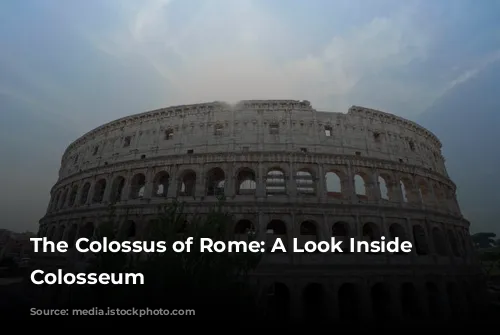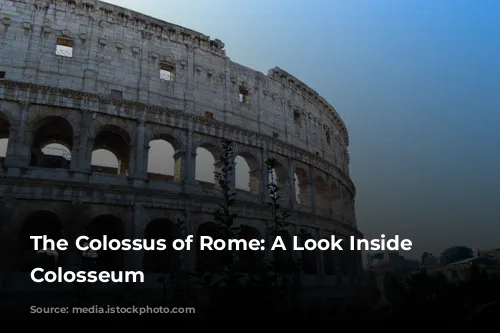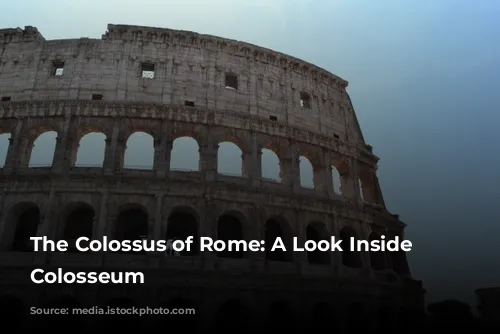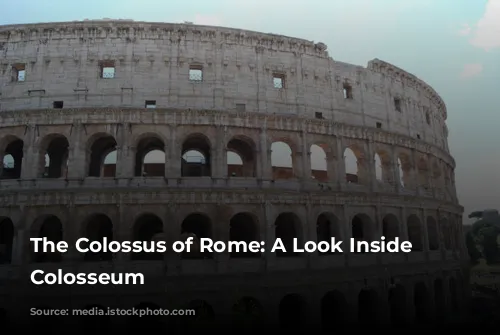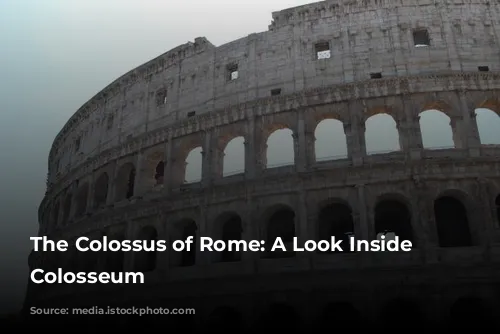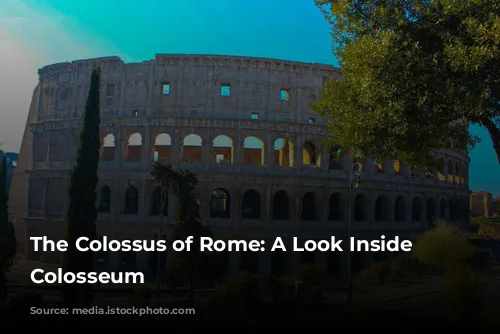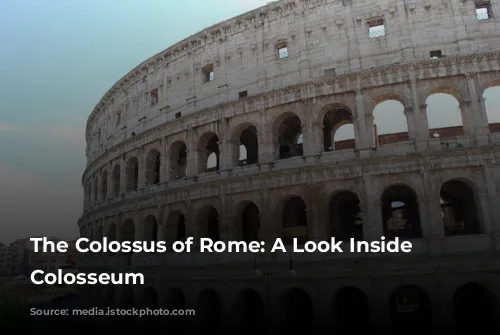The Colosseum, the most iconic monument in Rome, was originally known as the Flavian Amphitheatre, named after the Flavia family of emperors. Emperor Vespasian, the founder of the Flavian dynasty, began its construction, and his son, Emperor Titus, officially opened it in 80 AD with a grand celebration lasting 100 days!
These festivities were an incredible spectacle, filled with gladiatorial combats, animal hunts, and even naumachias, simulated naval battles. The historian Suetonius writes that during the opening, over 5000 animals were slaughtered for the entertainment of the Roman people.
Why the Colosseum?
The name “Colosseum” is a much later addition. The first recorded mention of the name comes from the prophecy of the Venerable Bede, a medieval monk. He predicted, “Rome will exist as long as the Colosseum does; when the Colosseum falls so will Rome; when Rome falls so will the world.” It’s thought that the name might come from the massive statue of the Emperor Nero, known as the “Colossus,” that once stood near the amphitheatre.
An Architectural Masterpiece
Imagine the Colosseum standing tall and proud, completely covered in white travertine stone. It’s an elliptical shape to accommodate as many spectators as possible. Four levels, each with 80 arches, rose towards the sky. The second and third levels were adorned with large statues, adding to the grandeur of the structure.
This immense building was built in a remarkably short time, less than ten years. The Romans were masters of the arch, an architectural marvel that allowed them to distribute weight effectively. The Colosseum can be seen as a series of aqueducts stacked one on top of the other.
A Glimpse into the Past
What we see today is just a skeleton of the once mighty arena. Over time, the Colosseum has suffered significant damage, with three-fifths of its outer brick wall missing. During the Middle Ages, it was used as a quarry for building materials, with marble, lead, and iron being taken to build structures like the Barberini Palace, Piazza Venezia, and even St. Peter’s Basilica.
The holes in the columns are a testament to the removal of these materials. The Colosseum could accommodate an astonishing 70,000 spectators, with the seating arranged according to social status. The upper tiers were reserved for the common people, while the lower tiers were reserved for the elite, including senators, vestals, priests, and the emperor.
The Sun and the Velarium
Similar to modern sports stadiums, the Colosseum had a clever way to shield spectators from the scorching Roman sun. The Velarium, a giant linen awning, was stretched across the arena by ropes, winches, and poles. It took 100 sailors from the Imperial fleet to maneuver this massive structure, moving it in perfect synchronization to the beat of a drum.
The Games Begin: A World of Spectacle
Entering the Colosseum, we see the arena, now empty of its once-thriving floor, a combination of brick and wood. Below, underground cellars housed the equipment needed for the games.
Here, lifts and hoists with counterweights, the special effects of the ancient world, were used to bring animals and gladiators into the arena through trapdoors, creating dramatic and surprising entrances. The same machinery could raise elaborate backdrops for hunting events, making the arena a versatile stage.
The shows in the Colosseum were more than just entertainment; they were a powerful symbol of Roman power and a way for citizens to connect with their leader. The games provided diversion, a welcome escape from the political dramas of the day.
Inside the Arena: From Animals to Gladiators
A typical day at the Colosseum involved a variety of events. The morning was dedicated to Venationes, fights between exotic animals, or between men and animals. Sometimes, public executions were also carried out, leaving individuals to the mercy of beasts.
The Silvae events were particularly spectacular, with painted scenery recreating a forest filled with animals. While some of these events involved the killing of animals, others were less brutal. One famous display involved an elephant that could write words in the sand with its trunk. The myth that Christians were systematically executed in the Colosseum as entertainment is simply false.
Around midday, the arena was cleared, the blood and debris were removed, and more sand was spread on the floor. Then, to the sound of trumpets and drums, the gladiators entered the arena.
The Glory of Gladiators
Gladiators entered from an underground passage connected to their barracks, the Ludus Magnus. They were greeted with cheers from their fans, much like modern sports heroes. After a short parade around the arena, they paid homage to the emperor, saluting with the famous phrase, “Ave Cesare morituri te salutant” (Hail Caesar, those who are about to die salute you).
Gladiators were not always forced into combat. Many were prisoners of war given the option of slavery or fighting in the arena for a limited time. Some were paupers seeking fame and fortune. Gladiators earned a good living and enjoyed a great deal of popularity, particularly among women, who often paid for their company.
Twelve different types of gladiators fought in the Colosseum. The Retiarius fought with a net, a trident, and a knife, while others used shields and sickles or heavy armor and javelins.
The crowd held power over the defeated gladiators, who could plead for mercy by raising an arm. The emperor, seated in his special box, would decide their fate: thumbs up meant life, thumbs down meant death.
Victorious gladiators were awarded golden palm leaves and large sums of money. Servants dressed like Charon, the ferryman of the underworld, ensured the death of the wounded, often finishing them off if necessary. Gladiator blood was believed to have healing powers, a belief that persisted for centuries.
Brutality and the Decline of the Colosseum
Roman spectators reveled in violence and the spectacle of the Colosseum. The crowds were enthralled by the blood and gore, much like some people today enjoy “splatter” films.
The difference was the reality of the violence, with the stench of blood, burnt flesh, and wild animals filling the air. No amount of incense or perfume could mask the brutality.
After the 6th century, with the decline of the Roman Empire, the Colosseum fell into disuse. Its walls became home to confraternities, hospitals, hermits, and even a cemetery. By the Middle Ages, it was one of the most recognizable landmarks in Rome, drawing visitors from all over the world.
Pope Sixtus V considered demolishing the Colosseum for its building materials, but it was saved by Pope Benedict XIV, who declared it a sacred monument dedicated to the Passion of Christ. He placed a cross on a pedestal, a symbol of the suffering of Christian martyrs. This cross is still the starting point for the Stations of the Cross on Good Friday.
A Timeless Legacy
The Colosseum has become a sacred place for Christians, protected from further destruction. Popes have continued to restore and preserve this magnificent monument.
For tourists today, a visit to the Colosseum is like stepping back in time, seeing “the ghost of old Rome” as Charles Dickens described it. It stands as a testament to the grandeur and brutality of the Roman Empire, a reminder of a bygone era that continues to fascinate and inspire.
